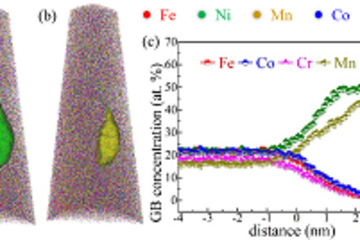All genres
681.
Talk
Are Mo2BC nanocrystalline coatings damage resistant? Insights from comperative tension experiments. 62. Metallkunde-Kolloquium, Werkstoffforschung für Wirtschaft und Gesellschaft , Lech am Arlberg, Austria (2016)
682.
Talk
Dislocation twin boundary interaction and its dependence on loading direction. 62. Metallkunde-Kolloquium, Lech am Arlberg, Austria (2016)
683.
Talk
Dislocation-grain boundary interaction at the micron scale: Insights by in situ Laue microdiffraction. Jung-DGM-Rhein-Ruhr, Aachen, Germany (2016)
684.
Talk
In-situ TEM isothermal annealing of nanocrystalline supersaturated Cu–Cr thin film alloys. 80th Annual Conference of the DPG and DPG Spring Meeting, Regensburg, Germany (2016)
685.
Talk
X-ray µLaue diffraction to understand plasticity at interfaces. DPG Frühjahrstagung 2016, Regensburg, Germany (2016)
686.
Talk
Slip transfer through coherent Σ3 (111) twin boundaries loaded in different crystallographic directions. DGM Arbeitskreis Treffen „Rasterkraftmikroskopie und nanomechanische Methoden"
, Saarland, Germany (2016)
687.
Talk
Unexpected Stress Induced Martensite Formation in Ultra-strong Pearlitic Steel. 2016 TMS Annual Meeting & Exhibition, Symposium: Advanced Characterization Techniques for Quantifying and Modeling Deformation
, Nashville, TN, USA (2016)
688.
Talk
Micro-scale fracture behavior of Co based metallic glass thin films. 2016 TMS Annual Meeting and Exhibition Symposium: In Operando Nano- and Micro-mechanical Characterization of Materials with Special Emphasis on In Situ Techniques, Nashville, TN, USA (2016)
689.
Talk
Mechanically driven martensite formation in ultra-strong pearlitic steel. Thermec 2016, Graz, Austria (2016)
690.
Talk
Investigation of solid state dewetting phenomena of epitaxial Al thin films on sapphire using electron microscopy. The 16th European Microscopy Congress (EMC 2016), Lyon, France (2016)
691.
Talk
Solid state dewetting of epitaxial Al thin films on sapphire studied by electron microscopy. Materials Research Society Fall Meeting & Exhibition 2016 (MRS Fall 2016), Boston, MA, USA (2016)
692.
Talk
A New Method to Study the Composition Dependence of Mechanical Properties of Laves. MRS Fall Meeting 2016, Boston, MA, USA (2016)
693.
Talk
Mikromechanik: lokale Einblicke in die mechanischen Eigenschaften von Materialien. Eröffnung des Christian Doppler Labors für
Lebensdauer und Zuverlässigkeit von Grenzflächen in komplexen Mehrlagenstrukturen der Elektronik „RELAB“, Vienna, Austria (2015)
694.
Talk
Transformation de phase induite par déformation plastique sévère des aciers perlitiques. XIe Colloque Rayons X & Matière, Grenoble, France (2015)
695.
Talk
New insights into the mechanical behavior of interface controlled metals. Colloquium Materials Modelling, Institut für Materialprüfung, Werkstoffkunde und Festigkeitslehre (IMWF), Universität Stuttgart , Stuttgart, Germany (2015)
696.
Talk
Deformation-driven phase transition in severely cold-deformation pearlitic steel. General Meeting on the Mechanics of Nano-Objects, Marseille, France (2015)
697.
Talk
Differences in deformation behavior of bicrystalline Cu micropillars containing different grain boundaries. MS&T 2015 (Materials Science and Technology) meeting, symposium entitled "Deformation and Transitions at Grain Boundaries", Columbus, OH, USA (2015)
698.
Talk
Structure and strength of metal-ceramic interfaces: New insights by Cs corrected TEM and advances in miniaturized mechanical testing. MS&T 2015 (Materials Science and Technology) meeting, Symposium entitled "Structures and Properties of Grain Boundaries: Towards an atomic-scale understanding of ceramics", Columbus, OH, USA (2015)
699.
Talk
Supersaturated ferrite in severely cold-drawn pearlitic steel - X-ray diffraction study. Pearlite Workshop, MPI für Eisenforschung GmbH, Düsseldorf, Germany (2015)
700.
Talk
Small Scale Mechanical Testing and its Impact on Materials' Applications. 14th International Union of Materials Research Societies-International Conference on Advanced Materials - Keynote Lecture, Jeju Island, Korea (2015)











